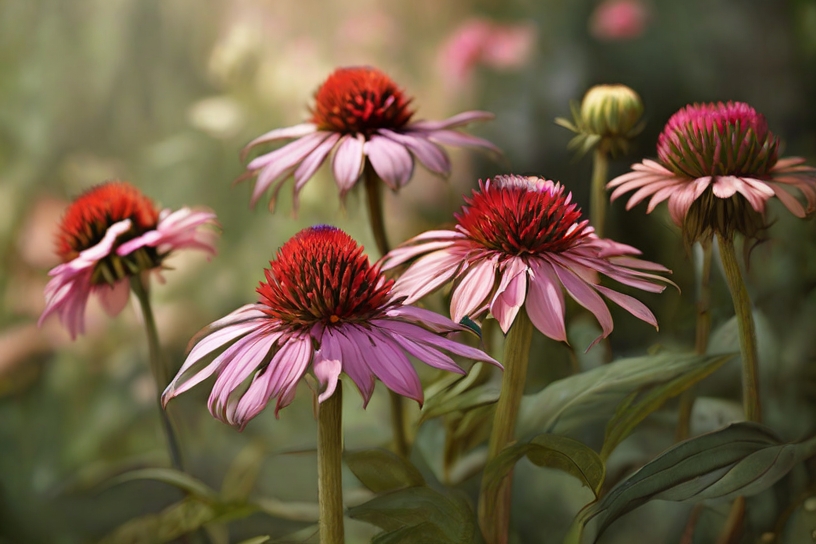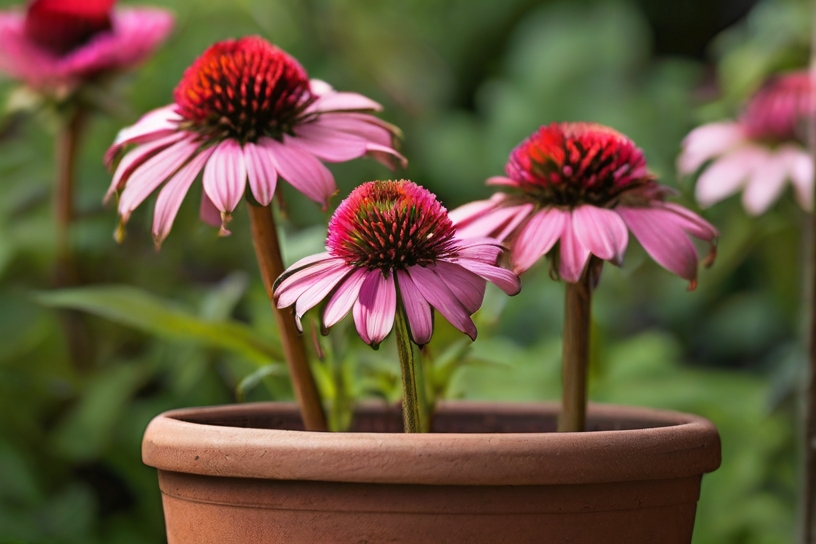Echinacea, also known as coneflower, is a beautiful and beneficial addition to any garden. Known for its vibrant colors and medicinal properties, growing echinacea from seed is a rewarding experience. Whether you’re a seasoned gardener or just starting out, this comprehensive guide will walk you through each step to successfully grow echinacea from seed. Let’s get started!
Table of Content
Introduction
Echinacea is a perennial flower native to North America. It’s highly valued for its immune-boosting properties and stunning blooms. By growing echinacea from seed, you can enjoy the benefits of this medicinal plant while adding a splash of color to your garden. Here is a video on growing echinacea from seed. If you don’t like videos, you can read the full guide below:
Step 1: Seed Selection and Preparation
To ensure successful germination, the first step is to select high-quality echinacea seeds. Look for reputable seed suppliers that offer fresh, viable seeds. Alternatively, you can save seeds from mature echinacea plants in your garden. To prepare the soil for germination, create a well-draining and nutrient-rich environment. You can do this by using containers or seed trays filled with a high-quality potting mix. Ensure the soil is loose, well-aerated, and free from any debris or clumps that could impede seedling growth.
Step 2: Sowing the Seeds

Sowing echinacea seeds correctly is essential for their successful growth. Follow the recommended sowing depth and spacing guidelines provided on the seed packet or by the supplier. Typically, echinacea seeds should be sown at a depth of about 1/4 inch (6 mm). You can either create shallow trenches in the soil or use individual containers for each seed. After placing the seeds in their designated spots, gently press them into the soil. This ensures good seed-to-soil contact, which is necessary for germination. After sowing, water the soil thoroughly to settle it around the seeds and provide the moisture needed for germination. Maintain a consistent temperature range between 65-75°F (18-24°C) to promote optimal germination.
Step 3: Germination and Seedling Care

As the echinacea seeds germinate, it’s important to provide them with the right conditions for healthy growth. Place the containers or trays in a location with ample light. Echinacea seedlings thrive in full sun, so if you’re growing them indoors, consider using grow lights to provide sufficient light intensity. Maintain a controlled temperature within the recommended range to encourage robust seedling development. While the seedlings are growing, it’s crucial to keep the soil consistently moist but not waterlogged. Overwatering can lead to rot, while underwatering can stress the young plants. To nourish the seedlings, you can use a diluted organic fertilizer to provide essential nutrients. Follow the fertilizer’s instructions for application, and avoid over-fertilizing, as this can harm the delicate seedlings.
Step 4: Transplanting
Once your echinacea seedlings have developed a strong root system and have produced several true leaves (leaves that resemble the mature plant’s leaves), it’s time to transplant them into their final garden location. Choose a sunny spot in your garden with well-draining soil. To prepare the planting area, remove any weeds and rocks and loosen the soil to a depth of at least 6 inches (15 cm). Echinacea plants prefer well-drained soil, so ensure that water won’t pool in the area. When transplanting, carefully remove the seedlings from their containers, being gentle to avoid damaging the roots. Space the seedlings according to the mature size of the echinacea variety you’re growing, typically around 18-24 inches (45-60 cm) apart. Plant them at the same depth they were growing in their containers, and water them thoroughly after transplanting to help settle the soil and reduce transplant shock. Continue to care for your echinacea plants by providing regular watering, mulching to conserve moisture, and removing any competing weeds as they grow to ensure they thrive in their new garden home.
Step 5: Maintenance and Care

Maintaining healthy echinacea plants requires ongoing attention. Here are some additional details for this step:
Watering: Echinacea plants benefit from consistent moisture. Water them deeply but less frequently, allowing the soil to dry out slightly between waterings. This encourages deep root growth and helps the plants withstand drought conditions. Early morning is usually the best time to water, as it allows the foliage to dry before evening, reducing the risk of fungal diseases.
Mulching: Apply a layer of organic mulch, such as straw, wood chips, or compost, around the base of your echinacea plants. Mulch helps to retain soil moisture, suppress weeds that may compete for resources, and maintain a more stable soil temperature.
Deadheading: To prolong the blooming period and encourage continuous flowering, deadhead (remove) spent flowers regularly. This prevents the plant from directing energy towards seed production and instead redirects it into producing new blooms. Use clean and sharp pruning shears or scissors to snip off the faded flowers just above a set of healthy leaves.
Pruning: In early spring, before new growth begins, consider pruning your echinacea plants. This can help promote bushier growth and prevent the plants from becoming too leggy. Trim the stems back to just above a set of healthy leaves. This pruning also allows for better air circulation, reducing the risk of fungal diseases.
Step 6: Pest and Disease Management
While echinacea is generally hardy and pest-resistant, it’s important to monitor your plants for potential issues. Here are more details on pest and disease management:
Aphids: Aphids can occasionally infest echinacea. To control them, you can spray the affected plants with a solution of water and a few drops of dish soap. This homemade insecticidal soap can help deter aphids. Alternatively, introduce beneficial insects like ladybugs, which are natural predators of aphids.
Powdery Mildew: Powdery mildew is a fungal disease that can affect echinacea in humid or poorly ventilated conditions. To prevent it, ensure good air circulation around the plants and avoid overhead watering. If powdery mildew appears, treat it with a fungicidal spray formulated for ornamental plants, following the manufacturer’s instructions.
Step 7: Harvesting and Using Echinacea
Harvesting and using echinacea can be a rewarding part of growing these plants. Here are some additional details:
Harvesting: Harvest echinacea flowers when they are fully open and vibrant in color. Use clean and sharp scissors or pruning shears to snip the flower heads just below the base of the petals. Collect the flowers on a dry, sunny day to minimize moisture content.
Drying: To preserve the medicinal properties of echinacea, dry the harvested flowers. Spread them out in a single layer on a clean, dry surface, such as a screen or a tray, and place them in a well-ventilated area away from direct sunlight. Once completely dry, store the flowers in an airtight container in a cool, dark place.
Using Echinacea: Echinacea can be used to make herbal teas, tinctures, or infused oils. It is commonly used to support immune health and may help with colds and respiratory issues. Before using echinacea for medicinal purposes, research proper usage and consult with a healthcare professional, especially if you are pregnant, nursing, or taking medications, to ensure it is safe and appropriate for your specific needs.
By following these steps and tips, you can successfully cultivate and care for your echinacea plants, enjoying their beauty and potential health benefits in your garden.
Frequently Asked Questions About Echinacea
1. How long does it take echinacea to grow from seed?
The time it takes for echinacea to grow from seed can vary, but it generally takes about 2 to 3 weeks for the seeds to germinate and several months to grow into mature plants.
2. Are echinacea seeds hard to grow?
Echinacea seeds are not typically considered hard to grow, but they do require specific conditions and care to ensure successful germination and growth.
3. Do echinacea seeds flower the first year?
Echinacea seeds may not flower in the first year. It often takes at least a year or more for echinacea plants to reach maturity and produce flowers.
4. Do echinacea need darkness to germinate?
Echinacea seeds do not require darkness to germinate. In fact, they usually germinate better in well-lit conditions.
5. Does echinacea like sun or shade?
Echinacea prefers full sun. It thrives in sunny locations with at least 6 hours of direct sunlight per day.
6. Is echinacea easy to grow?
Echinacea is generally considered easy to grow, but it requires proper care and attention to detail, especially during the germination and seedling stages.
7. Can Echinacea grow in full sun?
Yes, Echinacea can grow in full sun, and it actually prefers sunny conditions.
8. How many years does it take Echinacea to bloom?
It typically takes 2 to 3 years for Echinacea plants to bloom from seed.
9. Can Echinacea grow in pots?
Yes, Echinacea can grow in pots, but it’s important to choose large enough containers and provide proper care to accommodate the plant’s growth.
10. Where is the best place to plant Echinacea?
The best place to plant Echinacea is in a sunny location with well-draining soil.
11. Does Echinacea flower all summer?
Echinacea can flower for an extended period, often from late spring through summer, depending on the variety and local climate.
12. Which type of Echinacea is best?
The best type of Echinacea may depend on your specific needs and preferences. There are various species and cultivars with different characteristics.
13. Why is Echinacea so expensive?
Echinacea can be expensive due to its popularity and the time it takes to grow from seed or propagate. High-quality plants may also command higher prices.
14. Why avoid Echinacea?
There is no need to avoid Echinacea, but it’s essential to use it responsibly and consult with a healthcare professional if using it for medicinal purposes, especially if you have specific medical conditions or are taking medications.
15. What is another name for Echinacea?
Another name for Echinacea is “coneflower.”
Conclusion
Congratulations! You’ve successfully grown echinacea from seed. By following these steps, you can enjoy the beauty and benefits of this remarkable plant in your own garden. Remember to save seeds from mature plants to continue the cycle of growth in the following seasons. Happy gardening!
Note: This guide is tailored for growing echinacea from seed. If you prefer to start with established plants, you can find potted echinacea plants at your local nursery.
To further enhance your knowledge and appreciation of echinacea, here are some additional facts about this versatile plant:
- Echinacea is a member of the daisy family (Asteraceae) and is closely related to other popular garden flowers such as sunflowers and black-eyed Susans.
- The name “echinacea” comes from the Greek word “echinos,” meaning hedgehog, referencing the spiky center of the flower.
- Echinacea is not only beneficial for humans but also attracts pollinators such as bees and butterflies to your garden.
- In addition to its immune-boosting properties, echinacea has been used for centuries by Native American tribes in various medicinal remedies.
- There are nine different species of echinacea, each with its unique characteristics and benefits.
- Echinacea is a hardy plant that can survive harsh winters and drought conditions, making it an excellent choice for low-maintenance gardens.
In conclusion, growing echinacea from seed is not only a rewarding experience but also a great way to support your health and the environment. With proper care and attention,

